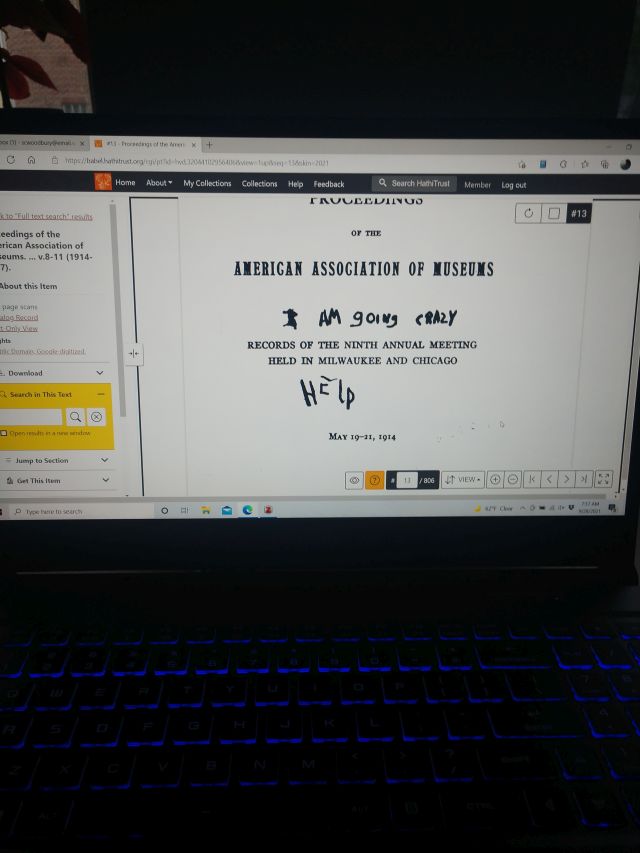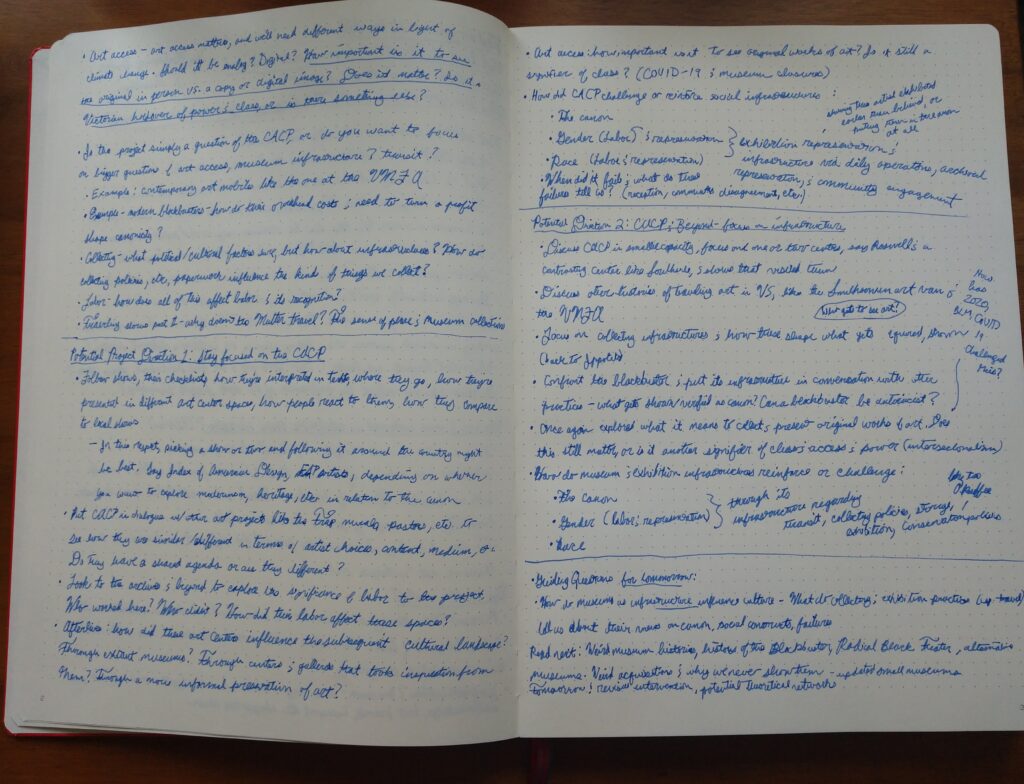Last month I shared how I wrote a very preliminary version of chapter 1, and how I took advantage of my training schedule at the Cohen Career Center to set up a daily habit of writing in short bursts. Today, I’ll talk about what I’ve been up to since then.

A lot of what I’ve been doing is filling in the research gaps of the draft, the areas where I knew I needed more information. While a lot of the archives I ultimately need to access for later chapters are still closed, there’s a lot of material I can access online, thanks to repositories like HathiTrust, JSTOR, the Internet Archive, and more. The Internet is hugely problematic, but it’s also a marvelous research tool, and has enabled me to keep working throughout this pandemic.
Among the archival resources I’ve been consulting are museum-related publications such as the annual proceedings for the American Association of Museums, now known as the American Alliance of Museums. Founded in 1906, they’ve been holding annual conferences since their founding, which luckily for me have been published. I’ve been going through these for references to outreach exhibits, whether in the form of actual exhibitions, or theoretical essays discussing the benefits of such installations. My main focus has been on art exhibitions, but I’ve also taken note of natural history exhibits and other subjects.

Among the most interesting has been the Educational Museum of St. Louis, founded in 1905 using leftover materials from the International Exposition held there the year before, and catering primarily to public schools within the city. Teachers would select boxes of specimens and artifacts from a special catalog, and a truck would deliver the order. The intersections between museums, warehouses, and consumerism is extremely interesting, and while it doesn’t relate directly to the museum-organized art exhibitions I’ve been focusing on, it’s something I’d definitely like to keep looking into, whether for a future article or a script for a podcast, something I’ve been thinking about trying for a while.
I’ve also been learning more about the overall exhibition environment from the turn of the century. As I’ve gathered from different period magazines and journals, traveling art exhibitions were quite common, with a variety of organizations hosting them. Museums were involved of course, but so were artists’ collectives, women’s clubs, and organizations specifically designed to provide exhibitions. Among the most prominent of these is the American Federation of Arts, founded in 1909 and still active today (I’m pretty sure I got more than a few brochures from them while I was in Roswell). Focused on sharing exhibitions of contemporary American art and related subjects to viewers on a national level, there are a lot of parallels between this organization and the Community Art Center Project that are worth exploring.
I’ve also been struck by the significance of women to these exhibitions, from the curators who supervised them at museums, to the social groups that facilitated them. Given the prominence of women working at the Community Art Center Project, it’s a thread I’d like to keep exploring.

Which brings me to an ongoing issue: the emerging forks in the road. While the prospectus offers a preliminary framework for the dissertation, it’s ultimately just that, preliminary. Like any exhibition or other major project, the dissertation’s focus changes and evolves as you start getting into the materials and get a better sense of what’s actually there. You learn about new topics, make new connections, and discover new directions to take the work. Some roads go nowhere, while others take you in unexpected directions. In short, the prospectus might offer a springboard for your research, but the actual dissertation often ends up looking pretty different.
That’s what I’ve starting experiencing. As with the prospectus process itself, I’ve been seeing different directions in which to take the piece, not as drastic as for that document but still distinct from one another. In all fairness, I expected change, but I’m a little surprised at how quickly it’s appeared, given that I’ve been dealing with what I consider background material. So as I start revising this draft, I need to take a closer look at these various forks and decide which ones to pursue moving forward. Ultimately I can’t follow all of them on this project, after all the best dissertation is the finished one, as one of my W&M colleagues has reminded me, but I can always save them for future projects.
And that’s okay. As I mentioned in a previous post, even if the dissertation bears little resemblance to the prospectus, that document will always remain valuable to me because it shows that my research ideas aren’t limited to one institution, artist, or time period. It proved to me that I’m not neither aimless in my research nor so focused that I’m a one-trick pony.
So I’ve got a plethora of material, multiple ideas and directions in which to take them, and am not entirely sure where to go next. As far as PhDs go, that sounds about right, so I’ll keep going.